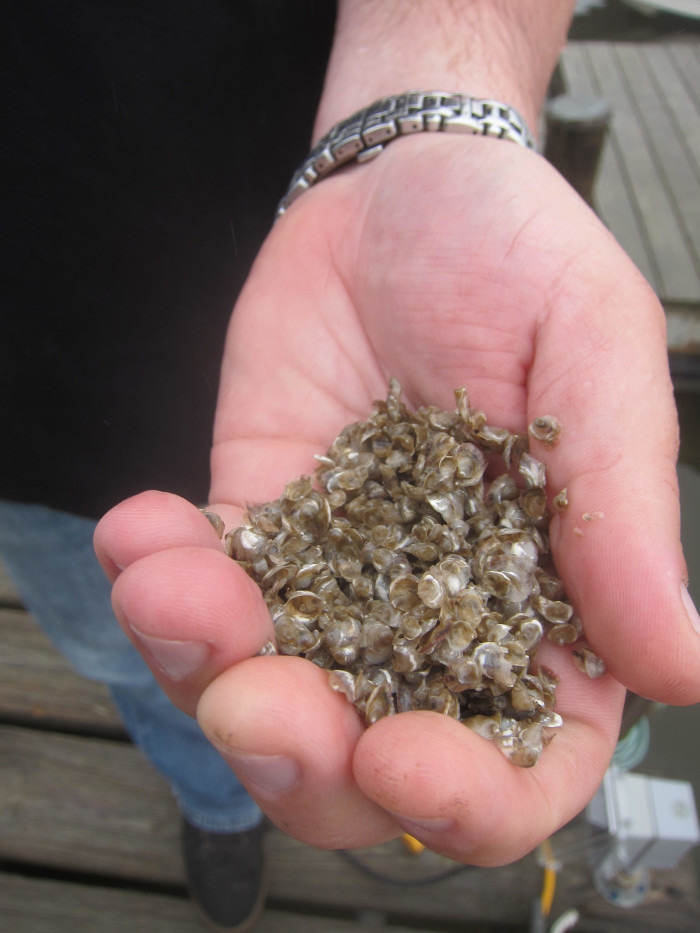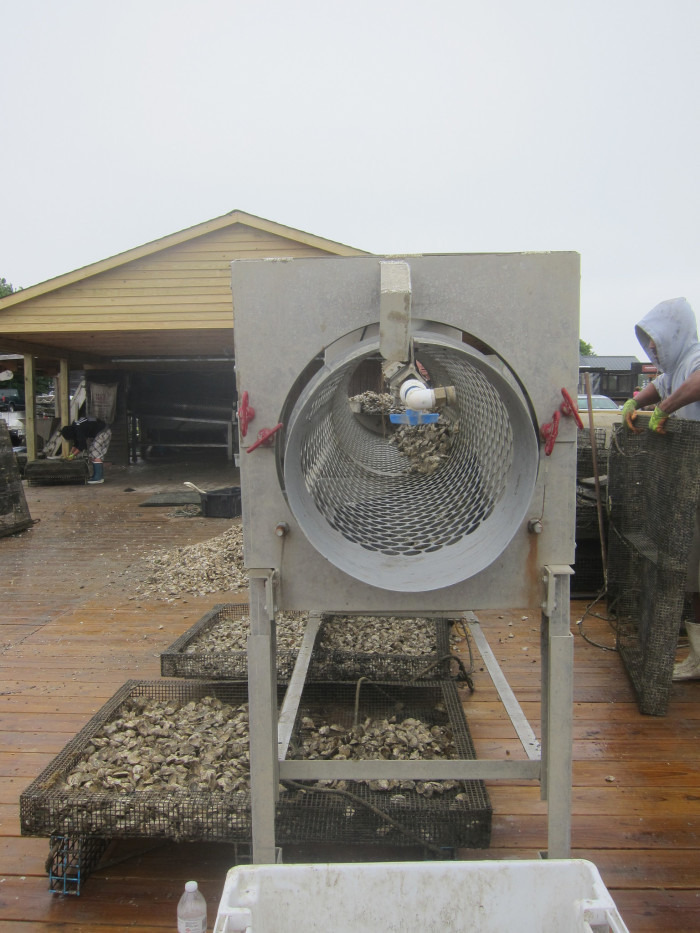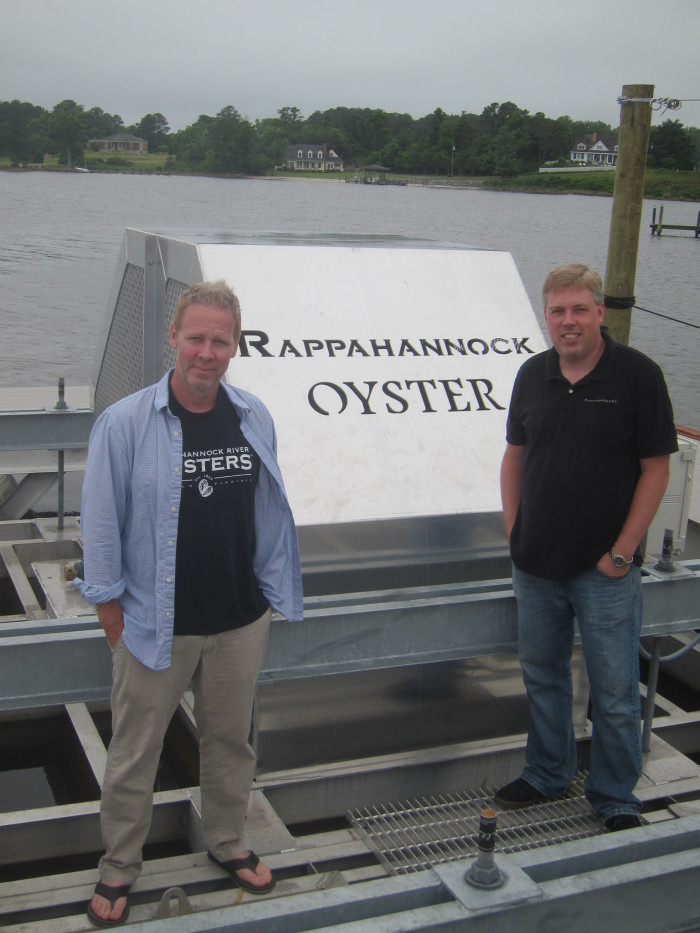At Rappahannock Oyster Company, Ryan And Travis Croxton Are Revitalizing Chesapeake Bay Aquaculture
Nashville-based writer Chris Chamberlain profiles chefs and restaurants with particular talents for classic and reinvented Southern dishes. Now, he's taking his investigations another link up the food chain as he travels to visit with some of those chefs' favorite farmers, ranchers and purveyors from across the South. In the Food Republic series Southern Grown , find out what makes these suppliers so special that chefs will go the extra mile to use these products in their kitchens.
When cousins Travis and Ryan Croxton decided to get into the oyster business in 2001, history was the main thing they had on their side. Since at least 1899, four generations of Croxtons had harvested Virginia oysters from what started out as a two-acre patch of the Rappahannock River bottom near the south-shore hamlet of South Hill under a state law that allowed individuals to lay claim to leased river bottom for the purpose of primitive aquaculture.
Over the years, the Croxton family purchased or harvested baby oysters called spat from public lands and moved them to their leased plot to grow for around three years until they were big enough to eat. These crude techniques were successful enough to make a living for over a century, but they also endangered the spawning grounds of the oysters by dredging and raking the riverbed. Eventually the oyster industry in the Chesapeake Bay and the rest of Virginia declined until Travis's and Ryan's fathers were ready to give up their claim on the traditional Croxton family grounds.
As their grandfather had discouraged their fathers from entering the family biz, Ryan and Travis already had moved on to careers in publishing and banking, respectively. But then one day their fathers asked if they had any interest in the family's 200 acres of oyster leases, which were about to retire. The cousins made the bold choice to jump into the family business, despite the fact that the Virginia oyster industry was near collapse and there was a move afoot to replace the native species with a Chinese variety. "When we got in the business," Travis recalls, "all we had were the family grounds, a dozen old photographs and a story." And like that, Rappahannock Oyster Company was back in business.
The cousins went online to search for information and procedures on how to grow oysters in a natural environment, and they discovered that the old Croxton ground had really degraded over the centuries. Not everyone knows that the vast majority of East Coast oysters are exactly the same species, and that the subtle nuances in size, shape and flavor are the result of growing practices and the individual environment of each particular oyster bed. The term coined to describe this is merrior.

With tides less than half as big as most West Coast oyster beds, the Croxtons couldn't replicate the specific practices of Pacific operations that they had visited. But they did learn about the rudiments of aquaculture and the benefits of using prefab cages that could raise the oysters above the thick silt in the bottom of the family beds. The Croxtons purchased minuscule seed oysters from a local supplier (10 million potential oysters can fit in your hand) and began to grow them in tanks, with the babies attaching themselves to grains of sands. A young oyster can double in size every week, so the early process involves constantly culling and separating them by size into different tanks in the hatchery until they are large enough to plant in the riverbed.

They installed their first crop of 3,000 oysters into beds in March 2002 and waited for harvest. Along the way, the Croxtons and their small staff of farmers raked the oysters out of bed and ran them through a tumbling machine, where metal grates separated them again by size and chipped off the edges of their shells. This practice creates a more uniform shell with the deeper cup favored by oyster eaters and also encourages the animals to put more energy into growing bigger instead of adding to their shells.
By 2004, the Croxtons were ready to see what the market thought of their new product. Travis recalls, "It was hard to sell in our own backyard because people preferred the cheaper, muddy Bay oysters instead. So we started at the top and went straight to New York City to introduce our oysters to chefs." The chefs liked their family story and the quality of their wares and began to introduce the cousins to a network of chefs across the country.
The Croxtons' first account was the prestigious Le Bernardin in Manhattan, where chef Eric Ripert and culinary director Chris Muller graciously invited them for a tasting, and within the next week were purchasing 200 oysters a week for the restaurant. "Le Bernadin helped us set our pricing," explains Travis. We didn't know what to charge and would have been selling ourselves short." Within the next year they were given Food & Wine magazine's Tastemakers Award, and chefs in New York City, Chicago, Los Angeles and Las Vegas were adding Rappahannock oysters to their menus.
Still, selling bivalves wasn't an easy task, and the cousins weren't yet comfortable with the sales process. Travis recalls, "We didn't eat in any of the great restaurants we were selling to. We were carrying coolers on the New York subway system and going to culinary events to meet people in the industry. We spent our weekends flying to Vegas and knocking on doors, but we never even got to do any gambling." Washington, D.C., chef Todd Gray had been buying their oysters for a while before he invited the cousins to sit down to eat at the bar. Travis admits, "It was the first time we'd ever seen our oysters served on a beautiful bed of rock salt and peppercorns, and we didn't know how to eat them. So we ate some of the rock salt and realized that was a big mistake."
Since that time, the Croxtons have become much more comfortable with fine dining and interacting with the chefs who love their products. Ryan says, "It's not sales anymore; it's sharing. We throw a lot of parties just to get folks to try them." Travis adds, "We've been around long enough that we have a large network of chef friends to recommend us, so that's made it a lot easier to open doors."
They have doubled their production every year and recently purchased a huge custom paddle wheel tumbler made by a metal fabricator at the end of the small road leading to their marina/production facility. "It's a game changer," notes Travis. "We haven't been able to satisfy the growing demand because of our seed oyster limitations." The new paddle wheel sorts the oysters so efficiently that Rappahannock could easily produce 40 million oysters in the next year.
Rappahannock now sells three different varieties of oyster to restaurants and on the Internet in quantities of 25-, 50-, 75- or 100-count bags. Orders are taken by phone or online, and boats are sent out to harvest to those exact numbers and specifications for same-day shipping in coolers with gel ice packs to keep the oysters alive and fresh until ready for shucking.
The Rappahannock River oysters are the flagship of the company, harvested near the mouth of the Rappahannock River, where the estuary meets the Chesapeake Bay. The mix of fresh and brackish water creates a sweet, buttery oyster with low underlying salinity, and the deep cup of the shell makes them excellent for slurping in volume. The Stingray oysters are exemplary Bay oysters harvested from a small bay where four rivers converge. The result is a mildly briny oyster with a crisp, clean finish. Finally, there is Olde Salt, Rappahannock's answer to chefs who requested a brinier ocean oyster. Grown off the coast of Chincoteague Island, Olde Salts offer the truest taste of the ocean.
This sort of responsiveness to chefs' requests is one of the reasons the Rappahannock brand has become so popular in notable kitchens across the country. Cosmo Goss from the Publican in Chicago singles Rappahannock out for its entire service model. "We take everything into account: how they handle the product, how it's grown, how it's taken care of, how it's shipped and how fast can it get to us. All of these things are really important, and with shellfish, freshness is the most important." He adds, "We source the best product we can from all over the world; we fly the fish we serve raw from Japan twice a week because we believe it's the best. I don't know that we're right, but we sure are stubborn!"
Chef Robert Wiedmaier of BRABO outside of Washington, D.C., swears by the Croxtons and their oysters. "Being a fisherman at heart, I appreciate the approach of the Croxton cousins and their strong passion for cultivating the best oyster that they would sit down and eat along with you and me. For them it is not about producing and selling as much as they can, which would be nice, but instead delivering a variety of oysters that provide a selection of tastes from mild to salty. You have to be confident in your purveyor when purchasing fresh enough to eat raw. I appreciate and respect those who harness their heritage and embrace it. These guys took into account how important their family's land was and wanted to revive the beds of plentiful oysters. It was hard work, and we want to support those individuals that have their heart and soul in their profession."
Katie Button from noted Asheville tapas emporium Cúrate is another big fan of the Croxtons. "We are purchasing their Stingray oysters from them. We serve them raw on the half shell and also fried in an oyster po'boy. We appreciate their regional proximity to us and the clean, delicious flavor of their oysters, and I also want to know about their impact on the environment. When I buy direct from the supplier, I know exactly when those oysters were removed from the water, and I have a much better handle on their shelf life. There are a lot of interesting products coming from the South right now. The purveyors I work with are really passionate about what they do and are striving for excellence in their area, whether that be oysters, clams, trout, sorghum syrup, grits, cheese, or olive oil. It's a really exciting time to be a chef in the South."

Another reason the Croxtons have such an excellent rapport with chefs is that they have become what they call "accidental restaurateurs" themselves.
"We just wanted to open a tasting room at our marina for Virginia wines, beer and oysters. We were doing a presentation to a group of chefs in Denver when a guy named Pete Woods came up and volunteered to be our chef," Ryan recalls. "We asked him how he prepared his crab cakes, and he responded, 'Just with crab meat, man,' and we knew we had our guy."
They converted a small building at the old marina they had purchased ("People still come in to buy fishing worms") and added a couple of grills purchased at their local Lowe's to cook oysters and fish; their restaurant, Merrior, opened in July 2011. The simple menu of raw and roasted oysters accompanied by fresh fish dishes, local wines and beer brought the locals flocking, and soon critics from D.C. began to take notice. Ryan figured it was about time. "Chesapeake oysters had been inconsistent and had gotten a bad rap in D.C."
They had to add some outdoor seating at picnic tables to accommodate the crowds that managed to overcome slightly sketchy GPS directions to find the small spit of land. They resisted the temptation to add a deep fryer, though. Travis states, "We didn't want to be just another clam shack. We really want to be a tasting room to support local farmers and fishermen."
Since then, the cousins have opened two other restaurants together, Rappahannock Oyster Bar, inside Union Market in D.C., and Rappahannock, in Richmond, with ex-Blackbird and Hungry Cat alum Dylan Fultineer helming the kitchen. The latter restaurant was named a 2014 Best New Restaurant by Esquire.
On his own, Travis Croxton has opened or partnered in several other restaurants, including Brine, in Fairfax, Virginia; two locations of Rocksalt, in Charlottesville, Virginia, and Charlotte, North Carolina; and a new venture in Richmond named after his partner, who is a member of "Earth's only openly extraterrestrial rock band," GWARBar. Go for the metal and music; stay for the Hail Seitan, an infernally spicy BBQ vegetarian plate.
Even with these forays into the restaurant business, Ryan and Travis Croxton know where their hearts remain. "We didn't want to lose our ancestral grounds. We wanted to keep a connection to the heritage, and we saw there was a stupid opportunity because nobody was practicing oyster aquaculture on a commercial basis," explains Ryan.
Travis adds, "While we were early to the game, dozens more operations join the business each year. But we have great sites to grow our oysters, and we think ours taste the best, though we're admittedly biased. If you choose to buy from us, you get our history, our integrity, and you support our future plans to help the region. It doesn't hurt that our oysters taste great, too."

